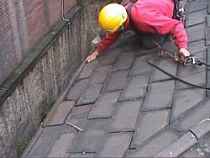[cycloneslider id=”homepage”]
The Evolution of Slating and Tiling Through the Years: A Journey from Ancient Practices to Modern Techniques
 Slating and tiling are ancient techniques that have been used by humans for centuries to protect and decorate their buildings. These methods, which involve covering roofs and floors with a series of tiles or slates, have evolved over time, blending both practicality and aesthetics. In the borough of Wandsworth, the tradition of slating and tiling has continued to shape the architectural landscape. Let’s explore the history, progress, and techniques behind slating and tiling, particularly with regard to Wandsworth’s rich architectural heritage.
Slating and tiling are ancient techniques that have been used by humans for centuries to protect and decorate their buildings. These methods, which involve covering roofs and floors with a series of tiles or slates, have evolved over time, blending both practicality and aesthetics. In the borough of Wandsworth, the tradition of slating and tiling has continued to shape the architectural landscape. Let’s explore the history, progress, and techniques behind slating and tiling, particularly with regard to Wandsworth’s rich architectural heritage.
The Early Beginnings of Slating and Tiling
The use of slates and tiles dates back to ancient civilizations. The Romans were known for their mastery of tile-making, using clay to create durable and water-resistant roofing tiles. These early tiles, often referred to as Roman tiles, had a characteristic S-shape that allowed them to overlap, providing a secure barrier against rain and harsh weather conditions. This technique was a precursor to what would become the modern slating and tiling we know today.
In medieval Europe, slate roofs became more widespread, particularly in areas where natural slate deposits were abundant. These slate roofs were prized for their durability and weather resistance. Wandsworth, with its access to high-quality slate materials, would eventually benefit from these advancements, incorporating slate roofing into its growing number of homes and public buildings during the late 19th and early 20th centuries.
The Role of Slating and Tiling in Wandsworth’s Architecture
Throughout the years, Wandsworth, an area in the southwest of London, has witnessed significant architectural changes. The Victorian era, with its booming population and industrial expansion, saw the rise of a wide range of building styles in Wandsworth. This period marked a significant turning point for the local building industry, as new materials, including slates and tiles, became more readily available.
During this time, the aesthetic value of slating and tiling became more pronounced. In Wandsworth, many homes and public buildings adopted tiled and slate roofs not only for their functional benefits but also for their decorative appeal. Architectural designs incorporated intricate patterns and vibrant colors, making tiles and slates an essential element of the local architectural identity. Key landmarks from this period, still standing today, showcase the prominent use of slates and tiles.
The Advancements in Slating and Tiling Techniques
The 20th century witnessed significant advancements in slating and tiling techniques, with modern materials and tools improving efficiency and design options. While traditional slate remained a staple for roofing in Wandsworth, the introduction of concrete and clay tiles provided new options for homeowners and builders. These materials, which were lighter and more cost-effective than natural slate, quickly gained popularity due to their durability and ease of installation.
With the rise of industrialization, mass production techniques made tiles more affordable and accessible to the general public. As a result, the demand for high-quality tiling increased. In Wandsworth, new housing developments and commercial buildings adopted a mix of slates and tiles, with each type offering its own set of advantages. The growth of residential areas like Battersea and Clapham further cemented tiling’s role in the city’s architectural aesthetic.
Modern Slating and Tiling: Innovation and Sustainability
In the 21st century, slating and tiling continue to evolve with a strong focus on sustainability and environmental considerations. The rise of green building practices has led to the development of eco-friendly materials that mimic the look of traditional slates and tiles. Modern roofing materials, such as synthetic slate, are designed to provide the same weather protection and aesthetic value without the environmental impact of quarrying natural stone.
In Wandsworth, there is a growing emphasis on using sustainable materials in both new builds and renovations. The demand for energy-efficient homes has made insulated tiles and slates a popular choice. These modern materials not only offer enhanced thermal performance but also contribute to reducing the carbon footprint of buildings. Additionally, the aesthetic flexibility of these materials means that they can be tailored to suit the unique architectural style of Wandsworth’s historic buildings, providing a perfect balance between tradition and innovation.
The Importance of Slating and Tiling in Wandsworth Today
As Wandsworth continues to evolve into a dynamic, urban borough, the legacy of slating and tiling remains an integral part of its identity. Whether in residential areas or public structures, the presence of quality tiling and slating reflects a commitment to both craftsmanship and modernity. Preservation efforts ensure that the historical use of slates and tiles continues to shape the visual landscape of the area.
Today, homeowners in Wandsworth are more conscious of the environmental impact of their building materials. Local suppliers of slates and tiles offer an increasing variety of sustainable products, ensuring that these time-honored techniques remain viable and relevant in the modern world.
Conclusion
From ancient Roman tiles to modern sustainable slates, slating and tiling have undergone a fascinating evolution through the years. Wandsworth, with its blend of historic and modern architecture, offers a perfect example of how these materials have shaped the built environment. As we look to the future, the continued development of slating and tiling techniques promises even more innovation, ensuring that this ancient craft remains a vital part of both tradition and progress.
In Wandsworth, the tradition of using slates and tiles is more than just a building practice—it’s a testament to the borough’s rich architectural heritage and its commitment to sustainable design practices moving forward.